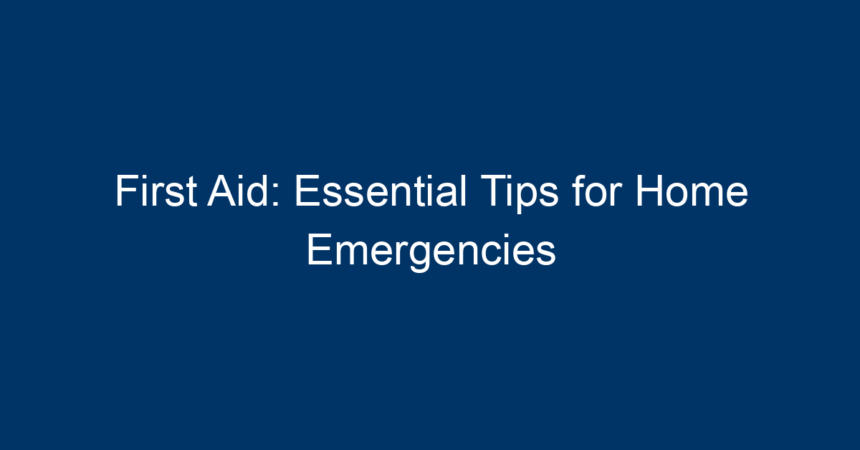In a world where the unexpected often occurs, knowing how to respond to home emergencies with basic first aid skills can make all the difference. Whether it’s a minor scrape, a burn, or something more serious, having the ability to administer first aid confidently can be life-saving. This comprehensive guide will equip you with essential tips for handling home emergencies effectively.
Understanding First Aid
First aid is the initial assistance provided to someone experiencing a medical emergency. It aims to preserve life, prevent further injury, or promote recovery. From knowing how to handle cuts and bruises to understanding basic CPR, the principles of first aid are invaluable.
Why Learning First Aid is Essential
- Immediate Response: Emergencies don’t wait for medical professionals. Knowing first aid helps you act quickly.
- Confidence: Being prepared for any situation boosts your confidence in emergencies.
- Potential Lifesaver: Basic skills can make a significant difference in critical moments.
Essential First Aid Supplies for Your Home
Before diving into various scenarios where first aid may be required, it’s crucial to ensure you have the right supplies on hand. Here’s a list of must-have items:
1. First Aid Kit
Every home should have a well-stocked first aid kit. Here are essential components to include:
- Bandages: Various sizes for cuts and abrasions.
- Antiseptic Wipes: To clean wounds and prevent infection.
- Gauze Pads: For larger wounds that need to be dressed.
- Adhesive Tape: To secure gauze and dressings.
- Scissors: For cutting tape, gauze, or clothing if needed.
- Tweezers: To remove splinters or debris from wounds.
- Instant Cold Packs: To reduce swelling and alleviate pain from sprains or bruises.
- Antihistamines: For allergic reactions.
- Burn Cream: To soothe and protect burns.
- CPR Face Shield: For emergency resuscitation.
2. Educational Resources
Having a first aid manual or guide is also essential. Familiarize yourself with it so you can quickly reference it during an emergency.
Common Home Emergencies and First Aid Responses
Understanding common emergencies and how to manage them is vital. Here are several scenarios along with effective first aid responses:
1. Cuts and Scrapes
What to Do:
- Clean the wound immediately with soap and water.
- Apply antiseptic to prevent infection.
- Cover with a sterile bandage.
Tip: If bleeding persists after applying pressure for 10 minutes, seek medical attention.
2. Burns
Types of Burns: First-degree (minor), second-degree (blistering), and third-degree (extensive damage).
What to Do:
- For first-degree burns, immerse in cool water for 10-20 minutes.
- For second-degree burns, cover with a sterile, non-stick bandage and don’t pop blisters.
- For third-degree burns, do not immerse in water; cover with a clean cloth and seek immediate medical attention.
3. Sprains and Strains
What to Do:
- Follow the R.I.C.E method (Rest, Ice, Compression, Elevation).
- Apply an ice pack wrapped in cloth for 15-20 minutes.
- Use a compression bandage and elevate the injured area.
Tip: If swelling continues or the pain intensifies, consult a healthcare professional.
4. Choking
What to Do:
- For an adult or child over 1 year, perform the Heimlich maneuver.
- Stand behind the person, make a fist, and thrust inward and upward below the ribcage.
- If the individual loses consciousness, begin CPR and call for emergency help.
5. Heart Attack
Signs: Chest pain, shortness of breath, and pain radiating to arms or jaw.
What to Do:
- Call emergency services immediately.
- Have the person chew an aspirin if they’re not allergic.
- Keep them calm until help arrives.
6. Allergic Reactions
What to Do:
- If the individual has a known allergy, administer their epinephrine auto-injector if available.
- If swelling or difficulty breathing occurs, call emergency services immediately.
First Aid for Children
Children can be prone to accidents and injuries, making it vital for caregivers to be prepared. Here are tailored tips for administering first aid to children:
1. Calm the Child
Reassure the child and remain calm yourself. Your demeanor can significantly influence their response.
2. Use Child-Specific Supplies
Ensure your first aid kit contains items suitable for children, like smaller bandages and child-friendly pain relievers.
3. Avoid Dangerous Chemicals
Use mild antiseptics like saline rather than alcohol on children’s wounds to prevent pain.
Education and Training in First Aid
While knowing these basics is invaluable, consider formal training through organizations like the Red Cross or other certified programs. Community courses often provide hands-on training that boosts confidence and skill.
Online Resources
Many reputable organizations provide online courses or videos that can enhance your understanding of first aid. Always opt for courses that provide certification upon completion.
Conclusion: Be Prepared, Stay Safe
In conclusion, knowing first aid is essential for handling emergencies at home effectively. Invest in a well-stocked first aid kit, educate yourself about common injuries, and practice first aid techniques regularly.
Empowering yourself with this knowledge not only helps you respond more effectively in emergencies but can also foster a sense of security in your home. Make first aid a priority—your family’s safety depends on it. Remember, being prepared is the best defense against the unexpected!




